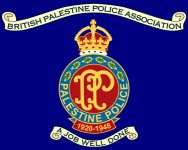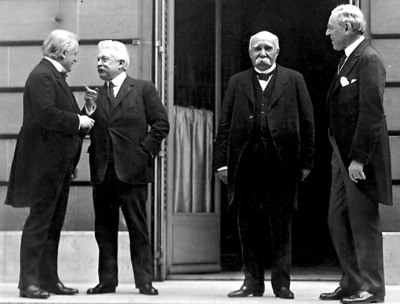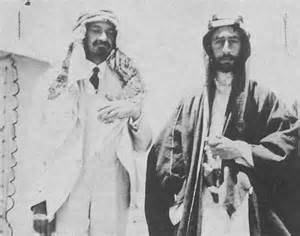Pages in Section 1

The Paris Peace Conference
ii. Situation Prior to August 1914
iii. WW 1 Protecting the Suez Canal
iv. WW 1 Promise 1
v. WW 1 Promise 2
vi. WW 1 Promise 3
vii. WW1 Conquest of Palestine
viii. O.E.T.A.
ix. 1919 Paris Peace Conference
x. Nebi Mussa Riots
xi. The Heroification of Trumpeldor
xii. St Remo Conference
|
The Paris Peace Conference was held at the Palace of Versailles. 27 nations had delegations with negotiating rights but the BIG 4 dominated the proceedings. The Paris Peace Talks were of immense interest to both Zionists and the sons of the Sharif of Mecca. Unfortunately neither the Arabs of Palestine and Syria nor the Kurds of Turkey and Iraq were consulted.
Prior to the Paris Peace talks, Prince Faisal, still temporary head of the Syrian administration invited Chaim Weizman, the Zionist leader to his HQ in Aqaba- with an eye to establishing favourable relations between Arabs and Jews in the Middle East. Prince Faisal headed an Arab delegation but his delegation had no negotiating powers. Chaim Weissman headed a Zionist delegation also without negotiating powers. Russia had signed a peace treaty with the Central Powers in the spring of 1918 so was not allowed to attend. The Central Powers - Austria-Hungary, Germany, Bulgaria and the Ottoman Empire - were not allowed to attend until details of all peace treaties had been agreed upon by the nations with negotiating rights. |
In regard to Palestine, the main points agreed on at the Paris Peace Conference, were:
- The setting up of the Covenant of the League of Nations.
- The acceptance of the Balfour Declaration.
- Agreement on a mandate system for those parts of the Arab and German Empires deemed unprepared for self-government.
- The setting up of the mandate system to be completed at a Conference in St Remo in 1920
- The French to administer Syria and Lebanon, the British to administer Palestine.
The outcome of the Paris talks came as a great shock to the Arabs and made the peace-keeping task of the Palestine Police, when formed, impossible. The immediate result of the Allied Agreements was that the treaty between Prince Faisal and Chaim Weissman became null and void. Prince Faisal sped back to OETA North to declare himself King of all Syria and conduct a rebellion against the French. The French took four months to dislodge him by shelling Arab villages loyal to Prince Faisal.
The Palestinian Arabs grew even more hostile to the Zionists. Before long the activities of a remarkable Zionist, Jabotinsky provoked the first major Arab riot in OETA South

